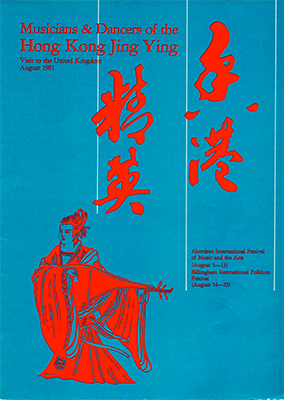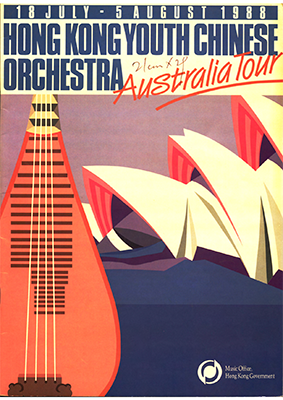A Very Short Introduction to Chinese Instrumental Ensembles
As of today, aside from the modern Chinese orchestra (zhongyuetuan, aka minzu yuetuan in Mainland China, guoyuetuan in Taiwan, and huayuetuan in Southeast Asia, North America, and Australia), most Chinese instrumental ensembles fall into the one of these five (i.e., four traditional and one modern) categories: 1. "silk and bamboo" ensembles (sizhu yue); 2. wind-and-percussion bands (chuida yue and guchui yue); 3. gongs-and-drums percussion ensembles (luogu yue); 4. bowed-and-plucked-string ensembles (xiansuo yue); and 5. monophonic ensembles (qizou) with either plucked-strings or bowed-strings. These categories distinguish themselves from each other by their inclusion of instruments from specific "family/families" (i.e., "material(s)" and playing method(s)) and/or the musical texture they are associated with. On top of that, within each of the four traditional categories, there are various regional genres whose repertoires, playing styles, and overall timbre contribute to their own cultural and musical distinctiveness.
Generally speaking, Chinese instrumental ensembles originated in court music, ritual music, festive music, and ceremonial music in ancient China. The instrumentation of these traditional ensembles was subject to designated performance venues as well as the aesthetics and social functions of the music being performed. Heterophony was the predominant musical texture for these traditional ensembles, although monophony might be present in certain genres of court music, ritual music, and ceremonial music. Large ensembles (of more than twenty players) were rare outside of the court, while regionality—an attribute that was particularly meaningful to music for commoners (su yue) - was often reflected in choices of instruments with unmistakable timbres. Bowed-string instruments were not included in these traditional ensembles until the Song Dynasty (960–1279) or after, and they were mainly treated as folk instruments until modern times.
Western art music was brought to China by missionaries during the Qing Dynasty (1644–1912). Notwithstanding, it was not an influence to Chinese instrumental ensembles until the early twentieth century, when Chinese nationalism gave rise to massive cultural reforms that inspired urban musicians, especially those who were well educated and well exposed to European high culture, to render their music comparable to the Western counterpart. On the one hand, the new and then prevalent practice of performing compositions and arrangements with written elaborated parts was facilitated by the swift adoption of staff notation and cipher notation. On the other hand, the modern Chinese orchestra, a new type of Chinese instrumental ensembles that was known for its prominent role in establishing a modern and national style of Chinese music, include Western instruments (such as cello and timpani) and elements of Western art music (such as functional harmony and equal temperament) as its key features. Musicians and composers were increasingly inclined to categorize and perceive Chinese instruments according to the playing method (i.e., wind (chui), bowed-string (la), plucked-string (tan), and percussion (da)) and the pitch range (i.e., "soprano" (gao yin), "alto" (zhong yin), and "bass" (di yin)) instead of the classical "eight materials" (ba yin) classification that highlights physical properties and timbral characteristics. The propagation of proletarian culture by Chinese communist "music workers" (yinyue gongzuozhe) between the 1940s and the 1960s also paved the way for the formation of bowed-string or plucked-string ensembles playing in monophony in a style like those Balalaika orchestras in the former Soviet Union.
Chinese Musical Instruments Classification
- a Winds
- a1 di
- a1.1 bang di
- a1.2 qu di
- a1.3 xin di
- a1.4 da di
- a1.5 ertong di
- a1.6 xiao
- a2 sheng
- a2.1 gaoyin sheng
- a2.2 zhongyin sheng
- a2.3 cizhongyin sheng
- a2.4 diyin sheng
- a3 suona
- a3.1 haidi
- a3.2 gaoyin suona
- a3.3 zhongyin suona
- a3.4 diyin suona
- a3.5 da suona
- a1 di
- a4 guan
- a4.1 gaoyin guan
- a4.2 zhongyin guan
- a4.3 diyin guan
- a5 bawu
- b1 yangqin
- b2 liuqin
- b3 pipa
- b3.1 ertong pipa
- b4 ruan
- b4.1 xiao ruan
- b4.2 zhong ruan
- b4.3 da ruan
- b5 sanxian
- b5.1 xiao sanxian
- b5.2 zhong sanxian
- b5.3 da sanxian
- b6 zheng
- c1 timpani
- c2.1 bass drum
- c2.2 snare drum
- c2.3 tambourine
- c2.4 hand drum
- c3.1 da gu
- c3.2 xiao gu
- c3.3 pai gu
- c3.4 ban gu
- c3.5 zhan gu
- c4.1 da luo
- c4.2 xiao luo
- c4.3 jing luo
- c4.4 shou luo
- c4.5 yunluo
- c4.6 fengluo
- c4.7 wu luo
- c4.8 mangluo
- c5 cymbals
- c5.1 large cymbals
- c5.2 medium cymbals
- c5.3 small cymbals
- c5.4 suspended cymbal
- c5.5 splash cymbal
- c6 triangle
- c7 ling
- c7.1 peng ling
- c7.2 chuan ling
- c8.1 sleigh bells
- c8.2 egg shaker
- c9.1 bangzi
- c9.2 castanets
- c9.3 muyu
- c9.4 woodblock
- c10.1 bianzhong
- c10.2 bianqing
- c10.3 percussion
- c11.1 glockenspiel
- c11.2 xylophone
- c11.3 marimba
- c11.4 vibraphone
- c12 sapayi
- d1.1 gaohu
- d1.2 erhu
- d1.3 zhonghu
- d1.4 gehu
- d1.5 diyin gehu
- d1.6 jinghu
- d1.7 jing erhu
- d1.8 banhu
- d1.9 dahu
- d1.10 dihu
- d1.11 ertong erhu
- e1.1 piccolo
- e1.2 flute
- e1.3 clarinet
- e1.4 oboe
- e1.5 bassoon
- e2.1 harp
- e2.2 piano
- e2.3 guitar
- e3 choir
- e3.1 women's voice
- e4.1 violin
- e4.2 viola
- e4.3 cello
- e4.4 double bass
Reference List
- Music Office: Chinese Musical Instruments
- Hong Kong Chinese Orchestra: Instrument R & D (Research and Development)
- Tsao, Penyeh. "Chinese Musical Instruments." Tradition and Change in the Performance of Chinese Music, Part I. Singapore: Harwood Academic Publishers, 1998, vii-xvi.
- Thrasher, Alan R. Chinese Musical Instruments. New York: Oxford University Press, 2000.
- 胡登跳 : 〈上篇: 樂器性能〉,《民族管弦樂法》。上海: 上海文藝出版社, 1981。
- 薛藝兵:《中國樂器志·體鳴卷》。北京: 人民音樂出版社,2003。
- 余少華:〈中國樂器分類方法〉, 《樂猶如此》。 香港: 國際演藝評論家協會,2005,頁11-18.
- 余少華:〈中國傳統樂器簡介及發展〉,《樂猶如此》。香港: 國際演藝評論家協會,2005,頁19-57。
- 曾遂今:《中國樂器志·氣鳴卷》。 北京:人民音樂出版社, 2010。

